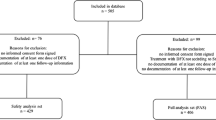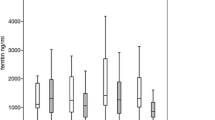Abstract
Emerging clinical data indicate that transfusion-dependent patients with bone marrow-failure syndromes (BMFS) are at risk of the consequences of iron overload, including progressive damage to hepatic, endocrine, and cardiac organs. Despite the availability of deferoxamine (DFO) in Korea since 1998, data from patients with myelodysplastic syndromes, aplastic anemia, and other BMFS show significant iron overload and damage to the heart and liver. The recent introduction of deferasirox, a once-daily, oral iron chelator, may improve the availability of iron chelation therapy to iron-overloaded patients, and improve compliance in patients who may otherwise find adherence to the DFO regimen difficult.



Similar content being viewed by others
References
Young NS. Acquired aplastic anemia. Ann Intern Med. 2002;136:534–46.
Alessandrino EP, Amadori S, Cazzola M, et al. Myelodysplastic syndromes: recent advances. Haematologica. 2001;86:1124–57.
Storb R. Aplastic anemia. J Intraven Nurs. 1997;20:317–22.
Jeong DC, Kang IJ, Koo HH, et al. Epidemiology and clinical outcomes in children with aplastic anemia in Korea: retrospective study. Korean J Pediatr Hematol-Oncol. 2004;11:137–52.
Lee HW, Choi JM, Kang SY, et al. Clinical characteristics and prognosis according to the classification of myelodysplastic syndrome. Korean J Med. 2006;70:253–60.
Lee JJ, Kim HJ, Chung IJ, et al. Comparisons of prognostic scoring systems for myelodysplastic syndromes: a Korean multicenter study. Leuk Res. 1999;23:425–32.
Lee JH, Lee JH, Shin YR, et al. Application of different prognostic scoring systems and comparison of the FAB and WHO classifications in Korean patients with myelodysplastic syndrome. Leukemia. 2003;17:305–13.
Germing U, Strupp C, Kundgen A, et al. No increase in age-specific incidence of myelodysplastic syndromes. Haematologica. 2004;89:905–10.
Porter JB. Practical management of iron overload. Br J Haematol. 2001;115:239–52.
Schafer AI, Cheron RG, Dluhy R, et al. Clinical consequences of acquired transfusional iron overload in adults. N Engl J Med. 1981;304:319–24.
Malcovati L, Della Porta MG, Pascutto C, et al. Prognostic factors and life expectancy in myelodysplastic syndromes classified according to WHO criteria: a basis for clinical decision making. J Clin Oncol. 2005;23:7594–603.
Jaeger M, Aul C, Sohngen D, Germing U, Schneider W. Secondary hemochromatosis in polytransfused patients with myelodysplastic syndromes. Beitr Infusionsther. 1992;30:464–8.
Cho D, Lee J, Sohn S, et al. Transfusion-related iron overload in Korea. Korean J Hematol. 2007;42(Suppl 2):11–2.
Takatoku M, Uchiyama T, Okamoto S, et al. Retrospective nationwide survey of Japanese patients with transfusion-dependent MDS and aplastic anemia highlights the negative impact of iron overload on morbidity/mortality. Eur J Haematol. 2007;78:487–94.
Ohnuma K, Toyoda Y, Nishihira H, et al. [Detection of early cardiac dysfunction in patients with transfusion-dependent aplastic anemia and chronic iron overload in childhood. Stress-velocity relation as a sensitive index by echocardiography]. Rinsho Ketsueki. 1996;37:825–32.
Malcovati L, la Porta MG, Cazzola M. Predicting survival and leukemic evolution in patients with myelodysplastic syndrome. Haematologica. 2006;91:1588–90.
Strasser SI, Kowdley KV, Sale GE, McDonald GB. Iron overload in bone marrow transplant recipients. Bone Marrow Transplant. 1998;22:167–73.
Armand P, Kim HT, Cutler CS, et al. Prognostic impact of elevated pretransplantation serum ferritin in patients undergoing myeloablative stem cell transplantation. Blood. 2007;109:4586–8.
Altes A, Remacha AF, Sarda P, et al. Early clinical impact of iron overload in stem cell transplantation. A prospective study. Ann Hematol. 2007;86:443–7.
Evens AM, Mehta J, Gordon LI. Rust and corrosion in hematopoietic stem cell transplantation: the problem of iron and oxidative stress. Bone Marrow Transplant. 2004;34:561–71.
Oguchi T, Kitano K, Kobayashi H, Saito H, Okamoto S, Kiyosawa K. Aplastic anemia complicated with secondary hemochromatosis after allogenic bone marrow transplantation. Rinsho Ketsueki. 1995;36:1188–92.
Bin JH, Yoo YK, Kim SY, et al. The effects of multiple transfusion on the outcomes of bone marrow transplantation from HLA-matched sibling donor in patients with severe aplastic anemia. Korean J Pediatr Hematol-Oncol. 2003;10:30–8.
Anderson LJ, Holden S, Davis B, et al. Cardiovascular T2-star (T2*) magnetic resonance for the early diagnosis of myocardial iron overload. Eur Heart J. 2001;22:2171–9.
St Pierre TG, Clark PR, Chua-anusorn W, et al. Non-invasive measurement and imaging of liver iron concentrations using proton magnetic resonance. Blood. 2005;105:855–61.
Olivieri NF, Brittenham GM. Iron-chelating therapy and the treatment of thalassemia. Blood. 1997;89:739–61.
Jensen PD. Evaluation of iron overload. Br J Haematol. 2004;124:697–711.
Gattermann N. Guidelines on iron chelation therapy in patients with myelodysplastic syndromes and transfusional iron overload. Leuk Res. 2007;31 Suppl 3:S10–5.
Leitch HA. Improving clinical outcome in patients with myelodysplastic syndrome and iron overload using iron chelation therapy. Leuk Res. 2007;31 Suppl 3:S7–9.
Rose C, Brechignac S, Vassilief D, et al. Positive impact of iron chelation therapy (CT) on survival in regularly transfused MDS patients. A prospective analysis by the GFM. Blood. 2007;110(11):abst 249.
Jensen PD, Jensen IM, Ellegaard J. Desferrioxamine treatment reduces blood transfusion requirements in patients with myelodysplastic syndrome. Br J Haematol. 1992;80:121–4.
Del Rio GJ, Fernandez LC, Batlle Fonrodona FJ. Desferrioxamine in the treatment of myelodysplastic syndromes. Haematologica. 1997;82:639–40.
Jensen PD, Heickendorff L, Pedersen B, et al. The effect of iron chelation on haemopoiesis in MDS patients with transfusional iron overload. Br J Haematol. 1996;94:288–99.
Jensen PD, Jensen FT, Christensen T, Nielsen JL, Ellegaard J. Relationship between hepatocellular injury and transfusional iron overload prior to and during iron chelation with desferrioxamine: a study in adult patients with acquired anemias. Blood. 2003;101:91–6.
Jensen PD, Jensen FT, Christensen T, Eiskjaer H, Baandrup U, Nielsen JL. Evaluation of myocardial iron by magnetic resonance imaging during iron chelation therapy with deferrioxamine: indication of close relation between myocardial iron content and chelatable iron pool. Blood. 2003;101:4632–9.
Porter J, Galanello R, Saglio G, et al. Relative response of patients with myelodysplastic syndromes and other transfusion-dependent anaemias to deferasirox (ICL670): a 1-year prospective study. Eur J Haematol. 2008;80:168–76.
Payne K, Desrosiers MP, Proskorovsky I, Ishak K, Baladi JF. Ferritin levels, non-compliance and adverse events in relation to infused iron chelation therapy in an international cohort of patients from actual practice. Haematologica. 2006;91 Suppl 1:abst 1059.
Desferal. Basic patient leaflet. Novartis. 1998.
Cappellini MD. Overcoming the challenge of patient compliance with iron chelation therapy. Semin Hematol. 2005;42:S19–21.
Miyata Y, Kajiguchi T, Saito M, Takeyama H. Development of arterial thrombus of Mucorales hyphae during deferoxamine therapy in a patient with aplastic anemia in transformation to myelodysplastic syndrome. Rinsho Ketsueki. 2000;41:129–34.
Spraul CW, Schicketanz C, Lang GE. Ocular side effects of deferoxamine therapy in aplastic anemia with transfusion-induced hemochromatosis. Klin Monatsbl Augenheilkd. 1996;209:31–6.
Multinational pharmaceutical firms launch seven new drugs. Pharma Koreana. 2008;17:15.
List AF, Esposito J, Decker J, et al. Iron parameters in 84 MDS patients enrolled in a deferasirox (Exjade®, ICL670) multicenter trial. Blood. 2006;108(11):abst 4847.
Gattermann N, Schmid M, Vassilieff D, et al. Severe iron overload in patients with myelodysplastic syndromes enrolled in a large study of deferasirox (Exjade®, ICL670). Leuk Res. 2007;31 Suppl 1:S109–10 (Abstract P129).
List AF, Baer MR, Steensma D, et al. Deferasirox (ICL670; Exjade®) reduces serum ferritin (SF) and labile plasma iron (LPI) in patients with myelodysplastic syndromes (MDS). Blood. 2007;110(11):abst 1470.
Cappellini MD, Vichinsky E, Galanello R, Piga A, Williamson P, Porter JB. Long-term treatment with deferasirox (Exjade®, ICL670), a once-daily oral iron chelator, is effective in patients with transfusion-dependent anemias. Blood. 2007;110:abst 2777.
Exjade® Swiss PI. http://www.exjade. com/pdf/Exjade_Swiss_PI_english. pdf (last accessed 30 October 2007). 2005.
National Comprehensive Cancer Network. NCCN clinical practice guidelines in oncology—v.1.2008: Myelodysplastic Syndromes. http://www.nccn.org/professionals/physician_gls/pdf/mds. pdf. 2008.
Bowen D, Culligan D, Jowitt S, et al. Guidelines for the diagnosis and therapy of adult myelodysplastic syndromes. Br J Haematol. 2003;120:187–200.
Alessandrino EP, Amadori S, Barosi G, et al. Evidence- and consensus-based practice guidelines for the therapy of primary myelodysplastic syndromes. A statement from the Italian Society of Hematology. Haematologica. 2002;87:1286–306.
Gattermann N, Porter J, Lopes LF, Seymour J. Consensus statement on iron overload in myelodysplastic syndromes. Hematol Oncol Clin North Am. 2005;19 Suppl 1:18–25.
Author information
Authors and Affiliations
Corresponding author
About this article
Cite this article
Lee, J.W. Iron chelation therapy in the myelodysplastic syndromes and aplastic anemia: a review of experience in South Korea. Int J Hematol 88, 16–23 (2008). https://doi.org/10.1007/s12185-008-0117-0
Received:
Accepted:
Published:
Issue Date:
DOI: https://doi.org/10.1007/s12185-008-0117-0




